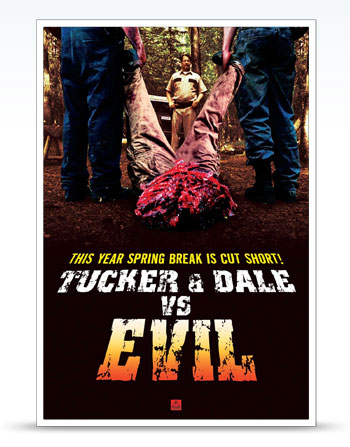 You know what? Let’s just say this right at the start: Tucker & Dale Vs. Evil could very well be the best horror-comedy made in a long, long time.
You know what? Let’s just say this right at the start: Tucker & Dale Vs. Evil could very well be the best horror-comedy made in a long, long time.
In fact, the brilliance of director Eli Craig’s first feature-length film can probably be summed up best by a line Alan Tudyk’s (Firefly/Serenity, Transformers: Dark of the Moon) character, Tucker, tells his best friend and fellow hillbilly, Dale (played by Reaper and Rise of the Planet of the Apes’ Tyler Labine), right around the midpoint of the film.
“It doesn’t matter what happened,” he says after one of the college kids camping in the woods nearby suddenly throws himself into their wood chipper. “What matters is what looks like what happened. And what happened looks pretty nasty.”
And that is what makes Tucker & Dale such a treat–the masterful way its director turns horror clichés on their head by having what “looks like what happened” only tell a fraction a fraction of the story.
Tucker & Dale vs. Clichés
In Tucker & Dale Vs. Evil a pair of good-natured hillbillies head off to the vacation home they bought together — a dilapidated shack in the middle of the woods — but soon discover that a group of rowdy, movie-cliché college kids are camping out in a plot just across the lake. When one of the girls from the group knocks herself unconscious due to a fall, Tucker and Dale rescue her, only to have her companions run off screaming, believing that — like the classic horror cliché — the hillbillies have kidnapped her with the intent of doing all sorts of terrible things.
As the movie progresses, this initial misunderstanding escalates into a series of gory accidents as the co-eds attempt to rescue their companion, only to die in horrible ways through no fault of Tucker and Dale, who just want a peaceful weekend to relax. As the body count rises, the pair soon find themselves up to their trucker hats in blood, trying to figure out why these darn college kids keep killing themselves all over their property.

Much to the filmmaker’s credit, the initial scenes of Tucker & Dale leave you a bit uncertain as to what type of movie this is going to be. Even going into the film knowing the basic premise, Craig manages to pull off a number of well-done, traditionally scary moments that seem to show that–if he really wanted to make a straight-up horror movie–he’d have no trouble doing so.
However, as we soon discover, this film is something else entirely.
Tucker & Dale vs. Predictable Filmmaking
One of the first things you’ll notice about Tucker & Dale is the creative way Craig uses a mix of camera angles, music, and other elements to give Tudyk and Labine’s characters a menacing tone whenever the college kids encounter them. Whether it’s intended to show us how the popped-collar co-eds view these hillbilly strangers, or a nod to the well-worn methods other horror directors use to build up their villains’ intimidation, it doesn’t really matter. The end result is a hilarious juxtaposition of reality and perception.

As the film rolls on, it would be easy to simply let the misunderstanding between the college kids and hillbillies go unresolved, and have Tudyk and Labine’s characters simply play the straight men to a funny series of Final Destination-like deaths. To Craig’s credit, though, the pair plays a much more involved role in the narrative. In these two friends who want nothing more than to work on their shack and do some fishing, Craig manages to develop a pair of characters you actively root for — and what’s more, can actually identify with despite their backwoods profiles.
Conclusion
When it comes down to it, I’m hard-pressed to come up with a pair of actors who might have done as good (or better) of a job than the Firefly and Reaper actors, and it serves as yet another example of the clever ways Craig has inverted the traditional horror-movie model.

In most films featuring a group of college kids battling killer hillbillies, any actors with names you might recognize usually fill roles among the co-ed victims, not the hillbillies. By casting Tudyk and Labine as the hillbilly title characters, this frees up the actors playing the confused college kids to over-act and otherwise play to all of the slasher-film conventions that are a staple of the genre.
As I mentioned at the start of this review, Tucker & Dale stands out as one of the best examples of true horror-comedy films made in quite a few years. Where most movies lumped into this genre are horror films that fail to the point of being funny or full-blown parodies of horror films that are more funny than scary, Tucker & Dale manages to find the perfect mix of both genres, and offers its audience the best of two worlds.
(Tucker & Dale vs. The World is rated R and has a running time of 89 minutes.)



